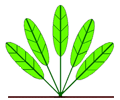


Blackmast or Strawman
Craterocephalus stramineus
General information: The Blackmast grows to approximately 75 mm. It has a silver green body with yellow fins and an elongated first few rays on the dorsal fin that are black in colour giving the appearance of a mast when the fins are erect. The first dorsal fin is longer in males than females. In its natural habitat it seems to prefer shallow faster running water where it lives in small schools. It is more common in the larger rivers where the water is hard and alkaline. It may be possible that these rivers produce more algae and have higher dissolved oxygen levels than billabongs and still water. I cannot recall finding these fish in a billabong adjacent any of the large rivers where they are common. The specimens cultured at Aquagreen are from the Fish River which is a tributary of the Daly River.
Cultivation notes : It is not as easy to keep as the rainbowfishes, It requires clean well oxygenated water and suffers when acidic conditions caused by lack of maintenance are present. It is reported to be an omnivore and may be worth trying out as an algae removing species, part of the clean up crew in a planted aquarium. It is able to be feed on a wide variety of prepared foods but will always do better with a couple of feeds with live foods and should have some greens in its diet each week. Suggested water quality would be temperature between 22 and 28, hardness approximately 100 ppm, carbonate hardness approx 110 ppm and pH around 7.5. The plants found in the harder more alkaline rivers of the Northern Territory are Schoenoplectus littoralis, Vallisneria nana, Najas tenuifolia, Hydrilla verticillata, Pogostemon stellatus, Ceratopteris thalictroides, Ammania baccifera, Goodenia purpurescens and Rotala occultiflora to name a few. The Blackmast breed as egg scatterers and are quite easily bred when correct water quality, plenty of space, and a good diet are provided. In a large well planted aquarium with a few adults, fry may be left with the parents but if numbers are required the parents should be removed as soon as fry are noticed. First foods for fry are small plankton and green water.
Distribution : This small forage species has a patchy distribution across the top of Queensland, Northern Territory and Western Australia.
Selling details : Sold individually
Reference: Allen, Midgley and Allen (2000) "Freshwater Fishes of Australia" , Merrick & Schmida (1986) "Australian Freshwater Fishes, Biology and Management"